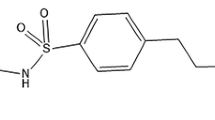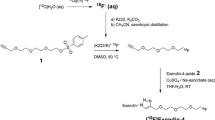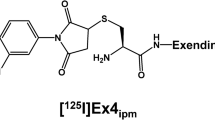Abstract
Objective
This study was aimed to assess pancreas beta cell activity using 99mTc-diethyleneaminepentaacetic acid-glipizide (DTPA-GLP), a sulfonylurea receptor agent. The effect of DTPA-GLP on the blood glucose level in rats was also evaluated.
Methods
DTPA dianhydride was conjugated with GLP in the presence of sodium amide, yielding 60%. Biodistribution and planar images were obtained at 30–120 min after injection of 99mTc-DTPA-GLP (1 mg/rat, 0.74 and 11.1 MBq per rat, respectively) in normal female Fischer 344 rats. The control group was given 99mTc-DTPA. To demonstrate pancreas beta cell uptake of 99mTc-DTPA-GLP via a receptor-mediated process, a group of rats was pretreated with streptozotocin (a beta cell toxin, 55 mg/kg, i.v.) and the images were acquired at immediately—65 min on day 5 post-treatment. The effect on the glucose levels after a single administration (ip) of DTPA-GLP was compared to glipizide (GLP) for up to 6 h.
Results
The structure of DTPA-GLP was confirmed by NMR, mass spectrometry and HPLC. Radiochemical purity assessed by ITLC was >96%. 99mTc-DTPA-GLP showed increased pancreas-to-muscle ratios, whereas 99mTc-DTPA showed decreased ratios at various time points. Pancreas could be visualized with 99mTc-DTPA-GLP in normal rat, however, 99mTc-DTPA has poor uptake suggesting the specificity of 99mTc-DTPA-GLP. Pancreas beta cell uptake could be blocked by pre-treatment with streptozotocin. DTPA-GLP showed an equal or better response in lowering the glucose levels compared to the existing GLP drug.
Conclusions
It is feasible to use 99mTc-DTPA-GLP to assess pancreas beta cell receptor recognition. 99mTc-DTPA-GLP may be helpful in evaluating patients with diabetes, pancreatitis and pancreatic tumors.







Similar content being viewed by others
References
Gepts W. Pathologic anatomy of the pancreas in juvenile diabetes mellitus. Diabetes. 1965;14(10):619–33.
Meier JJ, Bhushan A, Butler AE, Rizza RA, Butler PC. Sustained beta cell apoptosis in patients with long-standing type 1 diabetes: indirect evidence for islet regeneration? Diabetologia. 2005;48(11):2221–8.
Butler AE, Janson J, Bonner-Weir S, Ritzel R, Rizza RA, Butler PC. Beta-cell deficit and increased beta-cell apoptosis in humans with type 2 diabetes. Diabetes. 2003;52(1):102–10.
Palmer JP, Fleming GA, Greenbaum CJ, Herold KC, Jansa LD, Kolb H, et al. C-peptide is the appropriate outcome measure for type 1 diabetes clinical trials to preserve beta-cell function: report of an ADA workshop, 21–22 October 2001. Diabetes. 2004;53(1):250–64.
Dwarakanathan A. Diabetes update. J Insur Med. 2006;38(1):20–30.
Robertson C, Drexler AJ, Vernillo AT. Update on diabetes diagnosis and management. J Am Dent Assoc. 2003;134 Spec No:16S–23S.
Polonsky KS, Given BD, Hirsch L, Shapiro ET, Tillil H, Beebe C, et al. Quantitative study of insulin secretion and clearance in normal and obese subjects. J Clin Investig. 1988;81(2):435–41.
Kargar C, Ktorza A. Anatomical versus functional beta-cell mass in experimental diabetes. Diabetes Obes Metab. 2008;10(Suppl 4):43–53.
Singhal T, Ding YS, Weinzimmer D, Normandin MD, Labaree D, Ropchan J, et al. Pancreatic beta cell mass PET imaging and quantification with [(11)C]DTBZ and [(18)F]FP-(+)-DTBZ in rodent models of diabetes. Mol Imaging Biol. 2011;13(5):973–84.
Aguilar-Bryan L, Clement JPt, Gonzalez G, Kunjilwar K, Babenko A, Bryan J. Toward understanding the assembly and structure of KATP channels. Physiol Rev. 1998;78(1):227–45.
Proks P, Reimann F, Green N, Gribble F, Ashcroft F. Sulfonylurea stimulation of insulin secretion. Diabetes. 2002;51(Suppl 3):S368–76.
Schwanstecher M, Schwanstecher C, Dickel C, Chudziak F, Moshiri A, Panten U. Location of the sulphonylurea receptor at the cytoplasmic face of the beta-cell membrane. Br J Pharmacol. 1994;113(3):903–11.
Pantalone KM, Kattan MW, Yu C, Wells BJ, Arrigain S, Jain A, Atreja A, Zimmerman RS. The risk of overall mortality in patients with type 2 diabetes receiving glipizide, glyburide, or glimepiride monotherapy: a retrospective analysis. Diabetes Care. 2010;33(6):1224–9.
Schneider S, Feilen PJ, Schreckenberger M, Schwanstecher M, Schwanstecher C, Buchholz HG, et al. In vitro and in vivo evaluation of novel glibenclamide derivatives as imaging agents for the non-invasive assessment of the pancreatic islet cell mass in animals and humans. Exp Clin Endocrinol Diabetes. 2005;113(7):388–95.
Schmitz A, Shiue CY, Feng Q, Shiue GG, Deng S, Pourdehnad MT, et al. Synthesis and evaluation of fluorine-18 labeled glyburide analogs as beta-cell imaging agents. Nucl Med Biol. 2004;31(4):483–91.
Schneider S, Ueberberg S, Korobeynikov A, Schechinger W, Schwanstecher C, Schwanstecher M, et al. Synthesis and evaluation of a glibenclamide glucose-conjugate: a potential new lead compound for substituted glibenclamide derivatives as islet imaging agents. Regul Pept. 2007;139(1–3):122–7.
Portha B, Tourrel-Cuzin C, Movassat J. Activation of the GLP-1 receptor signalling pathway: a relevant strategy to repair a deficient beta-cell mass. Exp Diabetes Res. 2011;2011:376509.
Kitabchi AE, Kaminska E, Fisher JN, Sherman A, Pitts K, Bush A, et al. Comparative efficacy and potency of long-term therapy with glipizide or glyburide in patients with type 2 diabetes mellitus. Am J Med Sci. 2000;319(3):143–8.
Prendergast BD. Glyburide and glipizide, second-generation oral sulfonylurea hypoglycemic agents. Clin Pharm. 1984;3(5):473–85.
Assadi M, Eftekhari M, Hozhabrosadati M, Saghari M, Ebrahimi A, Nabipour I, et al. Comparison of methods for determination of glomerular filtration rate: low and high-dose Tc-99m-DTPA renography, predicted creatinine clearance method, and plasma sample method. Int Urol Nephrol. 2008;40(4):1059–65.
Hui YH, Huang NH, Ebbert L, Bina H, Chiang A, Maples C, et al. Pharmacokinetic comparisons of tail-bleeding with cannula- or retro-orbital bleeding techniques in rats using six marketed drugs. J Pharmacol Toxicol Methods. 2007;56(2):256–64.
Wangler B, Beck C, Shiue CY, Schneider S, Schwanstecher C, Schwanstecher M, et al. Synthesis and in vitro evaluation of (S)-2-([11C]methoxy)-4-[3-methyl-1-(2-piperidine-1-yl-phenyl)-butyl-carbam oyl]-benzoic acid ([11C]methoxy-repaglinide): a potential beta-cell imaging agent. Bioorg Med Chem Lett. 2004;14(20):5205–9.
Wangler B, Schneider S, Thews O, Schirrmacher E, Comagic S, Feilen P, et al. Synthesis and evaluation of (S)-2-(2-[18F]fluoroethoxy)-4-([3-methyl-1-(2-piperidin-1-yl-phenyl)-butyl-carbamoyl]-methyl)-benzoic acid ([18F]repaglinide): a promising radioligand for quantification of pancreatic beta-cell mass with positron emission tomography (PET). Nucl Med Biol. 2004;31(5):639–47.
Mishra AK, Hazari PP, Shukla G, Goel V, Chuttani K, Kumar N, et al. Synthesis of specific SPECT-radiopharmaceutical for tumor imaging based on methionine: (99m)Tc-DTPA-bis(methionine). Bioconjug Chem. 2010;21(2):229–39.
Mishra AK, Kakkar D, Tiwari AK, Chuttani K, Kaul A, Singh H. Comparative evaluation of glutamate-sensitive radiopharmaceuticals: technetium-99m-glutamic acid and technetium-99m-diethylenetriaminepentaacetic acid-bis(glutamate) conjugate for tumor imaging. Cancer Biother Radiopharm. 2010;25(6):645–55.
Hossain GA, Moinul Islam SM, Mahmood S, Khan N, Chakrabarty RK. Tc-99m DTPA scintigraphy in soft tissue tumor. Mymensingh Med J. 2005;14(2):185–8.
Simpson NR, Souza F, Witkowski P, Maffei A, Raffo A, Herron A, et al. Visualizing pancreatic beta-cell mass with [11C]DTBZ. Nucl Med Biol. 2006;33(7):855–64.
Christ GJ, Day N, Santizo C, Sato Y, Zhao W, Sclafani T, Bakal R, Salman M, Davies K, Melman A. Intracorporal injection of hSlo cDNA restores erectile capacity in STZ-diabetic F-344 rats in vivo. Am J Physiol Heart Circ Physiol. 2004;287(4):H1544–53.
Goldstein R, Meyer T. Role of everolimus in pancreatic neuroendocrine tumors. Expert Rev Anticancer Ther. 2011;11(11):1653–65.
Snigur GL, Pisarev VB, Spasov AA, Samokhina MP, Bulanov AE. Mechanisms of toxic effect of streptozotocin on beta-cells in the islets of Langerhans. Bull Exp Biol Med. 2009;148(6):937–9.
Acknowledgments
This work was supported in part by MDA Sponsored Research Grant (SR 2002-00007147SM, MDACC), by Cell>Point LLC Biotechnology (Englewood, CO), by a grant of ICSR (CNUHRICM-U-200518, Korea) and the John S. Dunn Foundation. The chemistry and animal research are supported by M.D. Anderson Cancer Center (CORE) Grant NIH CA-16672.
Author information
Authors and Affiliations
Corresponding author
Rights and permissions
About this article
Cite this article
Oh, CS., Kohanim, S., Kong, FL. et al. Sulfonylurea receptor as a target for molecular imaging of pancreas beta cells with 99mTc-DTPA-glipizide. Ann Nucl Med 26, 253–261 (2012). https://doi.org/10.1007/s12149-011-0569-9
Received:
Accepted:
Published:
Issue Date:
DOI: https://doi.org/10.1007/s12149-011-0569-9




